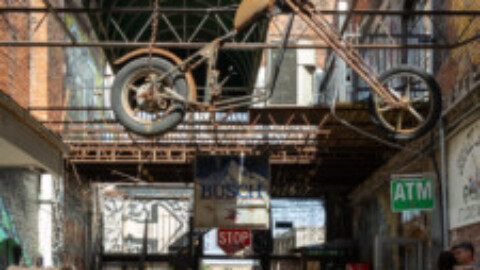
photo by Ann Aurbach
Academy is a north side neighborhood with a tremendously intact built environment and variegated history. It is one of the last two neighborhoods for PFSTL to cover along the “Delmar Divide”, a racial and socio-economic division that separates the mostly black north side from the mostly white south side. The neighborhoods that parallel this line (both north and south) are significant in that they showcase extremes in the spectrums of wealth, class and opportunity; a far wider gulf than is imaginable for most communities in the Unites States separated by a mere four lanes of traffic.

photo by Maureen Minich

photo by Jason Gray

photo by Liz McCarthy

photo by Mike Matney
Like many neighborhoods in St. Louis, Academy’s history begins with a powerful French surname. In this case, the Cabanne family. Jean Pierre Cabanne moved to the area from France in the early 1800’s, ahead of the influx of other ethnicities from Europe, when the then town of St. Louis still possessed mostly French-speakers, and opportunities abounded for land acquisition and wealth in the fur trade. This was exactly Cabanne’s path. After establishing himself in John Jacob Astor’s American Fur Company, where he interacted with the Chouteaus, Jean Pierre married into the prestigious Gratiot family.
Following his marriage in 1819, Jean Pierre Cabanne built his farmhouse on a vast tract of land that he had earlier acquired via Spanish Land Grant. This land comprises much of what today is Academy, though included parts of what is now Forest Park (in fact, the Cabanne House in Forest Park near Lindell and Union was built to commemorate the Cabanne’s original farmstead- said to be the first farmhouse west of the Mississippi).

photo by Ann Aurbach

photo by Vivian Nieuwsma

photo by Kate Cawvey

photo by Jane DiCampo
Things proceeded relatively idyllically for the Cabannes, whose later familial trades included dairy products sourced from their cows that grazed the pastures of early Academy and Forest Park. In 1876, the Cabanne’s descendants were instrumental in helping to pass the legislation separating St. Louis City from St. Louis County, which also extended the city’s boundaries and provided for the creation of Forest Park.
With all of this attention focused on land under their control, the Cabannes began to sell off their property for development. This original investment boom for Academy was spurred also by the extension of the Hodiamont streetcar line through the neighborhood, and the boon of St. Louis’ nearby hosting of the Louisiana Purchase Exposition in 1904. From about 1890-1910, most of the residential, commercial, municipal, and other buildings that still exist today were constructed for a well-established, St. Louis middle class. This includes the two Ittner-designed school buildings of the area (William Clark and Soldan), and the Carnegie-funded Cabanne Library (the second Carnegie design in St. Louis after the Central Branch Library). This was an era of excess prosperity for Academy.

photo by Kate Cawvey

photo by Diane Sieckmann

photo by Vivian Nieuwsma

photo by Jane DiCampo
After the floods of German, Irish, Italian and Polish immigrants of the 19th century, St. Louis experienced a rapid increase of Jewish immigrants between the World Wars. During the 20th century, this population moved continually west from its original settlements Downtown. Much of this movement was spurred by new opportunities, though the pattern of this migration, like that of African-Americans in St. Louis, was impeded due to the widespread use of restrictive deed covenants. Therefore, neighborhoods that did not extensively enforce those sorts of real estate covenants, like Academy, became prime centers for Jewish culture and life in the city. Following the relocation of the Jewish Hospital (now Barnes-Jewish), from Downtown to the Central West End in 1927, Academy and nearby Fountain Park received many new Jewish residents. Remarkably, the Jewish communities of St. Louis retained disproportionately greater diversity, especially with regard to African-Americans, than others because of the lack of deed covenant enforcement.
After World War II, the Jewish community of Academy, like much of the white community of north St. Louis, moved on to the suburbs creating the familiar pattern of disinvestment and decline that continues to plague neighborhoods across the city.

photo by Maureen Minich

photo by Vivian Nieuwsma

photo by Jason Gray
Today, Academy is a neighborhood that is mostly holding steady, despite a continuing decrease in population. What population remains tends to be increasingly renter occupied, often short-term and section 8. Those who own property here (and live there) are overwhelmingly residents that have lived in their homes for at least a generation, though there have been small waves of preservation-minded folks moving in since 2000. The effect of this is a mixture of attitudes toward intruders like Photo Flood Saint Louis, walking around the neighborhood aiming cameras and starting conversations. On this Flood, our small group of a dozen experienced everything ranging from polite curiosity to aggressively worded confrontations (not dissimilar to what we experienced in nearby Fountain Park). Collectively, this is a good thing. It means that residents care enough about their neighborhood and neighbors to ask questions or to stand up for behavior they may see as suspicious. In terms of the homes here, Academy is absolutely gorgeous, and features a building stock very similar to Tower Grove South. There is so much potential here, perhaps more than in any other north side neighborhood in 2020. Our sincere hope is that it gets realized in a way that’s healthy for (especially) long-time residents.

photo by Liz McCarthy

photo by Mike Matney

photo by Diane Sieckmann

photo by Liz McCarthy






